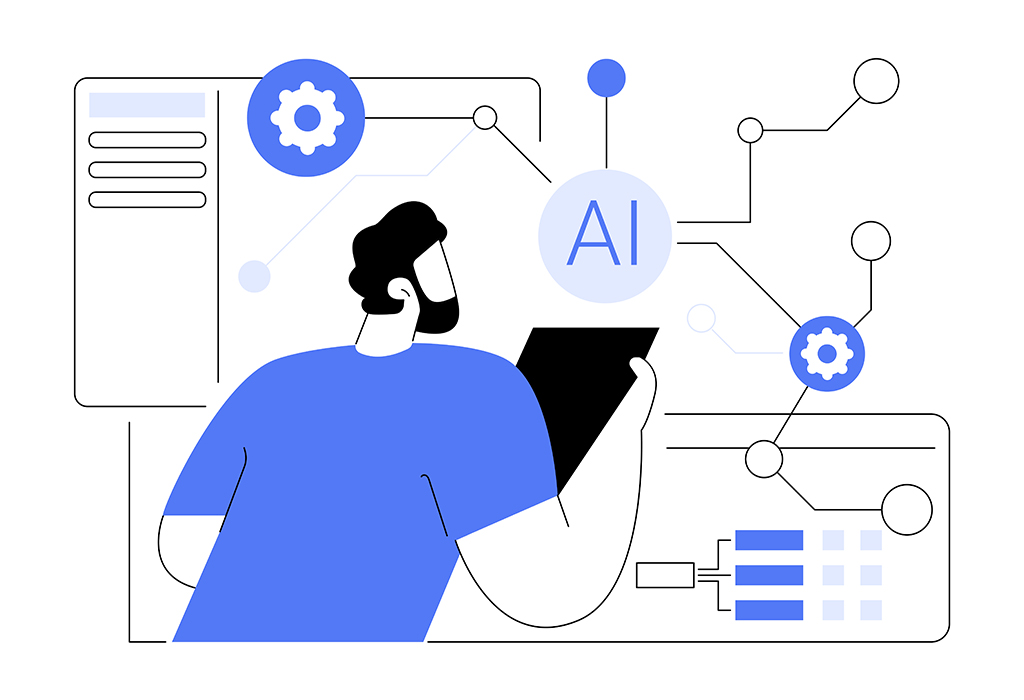Manufacturing is an ever-changing industry that relies on innovation. Integrating artificial intelligence (AI) solutions with servitized business models opens up a wide range of possibilities for creating customer value. It transforms traditional product development processes and changes how manufacturers work with customers to achieve desired outcomes.
Author Radiana Pit | Copperberg

Photo: Freepik
AI is becoming ubiquitous in manufacturing, and the global market is expected to reach $20.8 billion by 2028, with a growth rate of 45.6%. Advanced technologies like industrial IoT and automation are driving this growth and enhancing efficiency across the industry.
The role of AI when designing for service
The integration of AI has a significant impact on product development strategies. Not only does it change the way manufacturers conceptualize and develop products, but it also changes how customer value is delivered. AI-driven product design places a greater emphasis on understanding and addressing the specific needs and preferences of customers.
In today’s economy, customers expect more than just products; they seek solutions that directly address their unique challenges and goals. And thanks to advancements in AI technology, manufacturers can now create designs that are perfectly aligned with service outcomes, providing customized solutions for each customer. This unlocks a wealth of opportunities for innovation and differentiation while fostering partnerships that are based on mutual success and profitability.
AI tools transform new product design
When designing new products, manufacturers must take into account several considerations that can often shift their focus from the customer value to the cost of production. And with expectations evolving around efficiency and sustainability, the product development process can become quite convoluted. AI solutions, ranging from tools for market analysis to idea generation and design optimization, can help make the process faster and more effective and ensure that the final product is more innovative, efficient, customer-centric, and sustainable.
- Machine Learning (ML) algorithms—commonly used for predictive analysis, ML models crunch historical data to forecast future trends, enabling the creation of products before market demands. Moreover, ML models fine-tune product designs with optimization parameters like material usage, cost, and performance efficiency. ML algorithms are also used for quality control, preventing potential design flaws, and ensuring that products meet quality standards before production.
- Deep Learning (DL) technologies—particularly convolutional neural networks, analyze design elements, identifying patterns and features crucial for performance and functionality. DL algorithms also generate innovative product designs, by drawing insights from existing datasets to offer alternatives. They further simulate various design scenarios, allowing manufacturers to gauge product performance under different conditions.
- Natural Language Processing (NLP)—helps manufacturers analyze customer feedback, market reports, and other unstructured data for informed decision-making regarding new product development. It also facilitates seamless communication among design teams, synthesizing verbal and written inputs to streamline collaboration.
- Computer vision systems—leveraging advanced algorithms, these systems validate designs against predefined standards, ensuring compliance and identifying flaws. When coupled with Augmented Reality (AR), computer vision also enables designers to test the product in virtual environments, facilitating spatial and ergonomic considerations.
- Reinforcement learning—automation facilitates informed decision-making between multiple design options based on the success of previous iterations. Combined with robotics, it also automates design processes, accelerating prototyping and physical testing phases.
AI’s potential in the design process cannot be understated. AI helps to fine-tune products for efficiency, cost-effectiveness, and sustainability. It provides tailored customization for individual customer preferences. It also expedites prototyping, optimizes inventory levels, predicts maintenance needs, and creates synergy between design teams. And even after the product launch, AI analyzes customer feedback for future design iterations and improvements.
AI-product design facilitates outcome-based contracts
Outcome-based contracts guarantee specific results that customers want. Manufacturers commit to delivering these results instead of just selling a product. This is on par with modern customer expectations. It gives customers peace of mind that they will get what they need without taking any risks. Outcome-based contracts also create better value for customers as manufacturers work together with them to achieve the results they want, adjusting the terms when needed to fit new regulations, technology integrations, or market trends.
When manufacturers commit to delivering specific outcomes, customers trust them more. They know that the manufacturer cares about their success and is willing to share the risks and rewards. This trust is the foundation of long-term relationships and repeat business.
AI has become instrumental in helping manufacturers deliver the outcomes they commit to and drive continuous improvement by:
- Predicting performance: AI simulations forecast service performance and reliability based on historical data, enabling proactive maintenance strategies and optimization.
- Optimizing service delivery: Manufacturers streamline service protocols and minimize downtime by automating routine tasks and proactively addressing potential issues identified by AI.
- Strengthening contracts: Accurate performance predictions enhance the value proposition of outcome-based contracts, increasing customer satisfaction and loyalty.
For instance, industrial manufacturers can help improve the reliability and performance of their equipment by simulating operations and analyzing data to ensure that everything functions optimally for minimal downtime. In the healthcare industry, medical device suppliers can use AI simulations to improve their designs and streamline clinical workflows to meet patient safety standards and regulatory compliance.
Likewise, automotive manufacturers can use AI to create more sustainable transportation solutions. They can simulate driving conditions and analyze telemetry data for optimal vehicle performance and fuel efficiency. They can thus establish contracts that prioritize environmental sustainability and customer satisfaction, which builds more trust and loyalty with conscientious consumers.
Continuous innovation
The integration of AI-driven design with outcome-based contracts is an important development in the manufacturing industry. It creates new opportunities for manufacturers to drive innovation, collaboration, and customer value. It is the key to creating smarter offerings with smarter contracts.
By embracing outcome-based contracts supported by AI design solutions, manufacturers can deliver concrete and measurable results, strengthen customer relationships, and drive sustainable growth in the era of everything-as-a-service.
As the industry continues to evolve, this synergy between AI-powered product design and service offerings will be instrumental in shaping market dynamics and redefining the customer-supplier relationship.






























